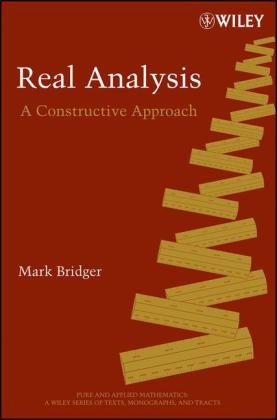Ulteriori informazioni
A unique approach to analysis that lets you apply mathematics across a range of subjects
This innovative text sets forth a thoroughly rigorous modern account of the theoretical underpinnings of calculus: continuity, differentiability, and convergence. Using a constructive approach, every proof of every result is direct and ultimately computationally verifiable. In particular, existence is never established by showing that the assumption of non-existence leads to a contradiction. The ultimate consequence of this method is that it makes sense--not just to math majors but also to students from all branches of the sciences.
The text begins with a construction of the real numbers beginning with the rationals, using interval arithmetic. This introduces readers to the reasoning and proof-writing skills necessary for doing and communicating mathematics, and it sets the foundation for the rest of the text, which includes:
Early use of the Completeness Theorem to prove a helpful Inverse Function Theorem
Sequences, limits and series, and the careful derivation of formulas and estimates for important functions
Emphasis on uniform continuity and its consequences, such as boundedness and the extension of uniformly continuous functions from dense subsets
Construction of the Riemann integral for functions uniformly continuous on an interval, and its extension to improper integrals
Differentiation, emphasizing the derivative as a function rather than a pointwise limit
Properties of sequences and series of continuous and differentiable functions
Fourier series and an introduction to more advanced ideas in functional analysis
Examples throughout the text demonstrate the application of new concepts. Readers can test their own skills with problems and projects ranging in difficulty from basic to challenging.
This book is designed mainly for an undergraduate course, and the author understands that many readers will not go on to more advanced pure mathematics. He therefore emphasizes an approach to mathematical analysis that can be applied across a range of subjects in engineering and the sciences.
Sommario
Preface
Acknowledgements
Introduction
0 Preliminaries
0.1 The Natural Numbers
0.2 The Rationals
1 The Real Numbers and Completeness
1.0 Introduction
1.2 Interval Arithmetic
1.3Fine Families
1.4Definition of the Reals
1.5 Real Number Arithmetic
1.6 Rational Approximations
1.7 Real Intervals and Completeness
1.8 Limits and Limiting Families
Appendix: The Goldbach Number and Trichotomy
2 An Inverse Function Theorem and its Application
2.0 Introduction
2.1 Functions and Inverses
2.2 An Inverse Function Theorem
2.3 The Exponential Function
2.4 Natural Logs and the Euler Number 3
3 Limits, Sequences and Series
3.1 Sequences and Convergence
3.2 Limits of Functions
3.3 Series of Numbers
Appendix I: Some Properties of Exp and Log
Appendix II: Rearrangements of Series
4 Uniform Continuity
4.1 Definitions and elementary Properties
4.2 Limits and Extensions
Appendix I: Are there Non-Continuous Functions?
Appendix II: Continuity of Double-Sided Inverses
Appendix III: The Goldbach Function
5 The Riemann Integral
5.1 Definition and Existence
5.2 Elementary Properties
5.3 Extensions and Improper Integrals
6 Differentiation
6.1 Definitions and Basic Properties
6.2 The Arithmetic of Differentiability
6.3 Two Important Theorems
6.4 Derivative Tools
6.5 Integral Tools
7 Sequences and Series of Functions
7.1 Sequences and Functions
7.2 Integrals and Derivatives o Sequences
7.3 Power Series
7.4 Taylor Series
7.5 The Periodic Functions
Appendix : Binomial Issues
8 The Complex Numbers and Fourier Series
8.0 Introduction
8.1 The Complex Numbers C
8.2 Complex Functions and Vectors
8.3 Fourier Series Theory
References
Index
Info autore
MARK BRIDGER, PHD, is Associate Professor of Mathematics at Northeastern University in Boston, Massachusetts. The author of numerous journal articles, Dr. Bridger's research focuses on constructive analysis, the philosophy of science, and the use of technology in mathematics education.
Riassunto
This book is both an introduction to the techniques and results of analysis as well as an introduction to mathematics itself. Through examples and elementary propositions, readers are introduced to the way mathematicians think about analysis, argue it, and write it.

